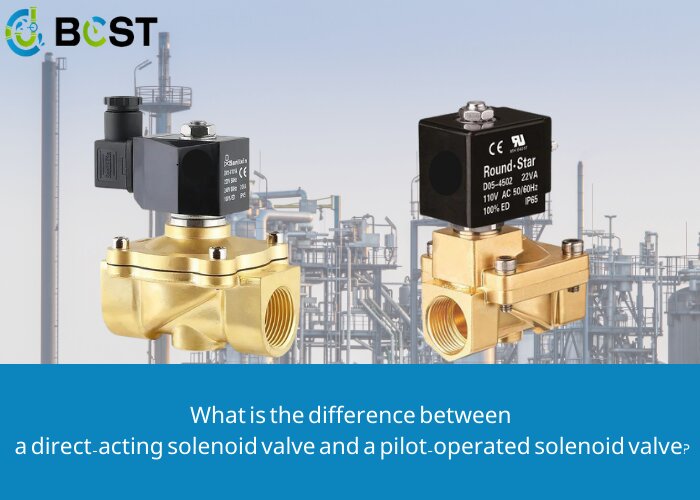
1. Principle of operation
1.1 Direct-acting solenoid valve
Direct-acting solenoid valve when energized, the electromagnetic coil generates electromagnetic force to lift the closing member from the valve seat, the valve opens; power failure, the electromagnetic force disappears, the spring closes the closing member pressed on the valve seat, the valve closes.

1.2 Pilot-operated solenoid valve
When energized, the electromagnetic force opens the pilot hole, and the pressure in the upper chamber drops rapidly, forming a low-pressure difference around the closing member, the fluid pressure pushes the closing member to move upward, and the valve opens; when de-energized, the spring force closes the pilot hole, and the inlet pressure passes through the by-pass hole to rapidly form a lower-lower-higher-pressure difference around the shut-off member, and the fluid pressure pushes the shut-off member to move downward, and the valve closes.

2. The difference between a Direct-acting solenoid valve and a pilot-operated solenoid valve
2.1 Pilot-operated on the purity of the circulating medium requirements are higher, but direct-acting is not so strict.
2.2 From the two to withstand the pressure size, pilot-operated type then through the pressure to withstand.
2.3 Direct-acting solenoid valve compared to the pilot-operated solenoid valve start speed, if you choose to use for rapid cut-off, it is recommended to use a direct-acting solenoid valve. Because the pilot-operated solenoid valve is energized after the small valve first opens, the main valve after the opening, direct-acting solenoid valve is the main valve directly open. But in most of the working conditions, the difference is not big.
2.4 Pilot-operated solenoid valves compared to the direct solenoid valve flow capacity to be larger, generally CV value of up to 3 or more, and direct solenoid valve general CV value is less than 1. Direct solenoid valves are by 0 pressure to start, while the pilot must have a pilot pressure, generally in the 2bar.
2.5 The power of the direct-acting type is larger than that of the pilot-operated type.
3. The selection of Direct-acting solenoid valve and pilot solenoid valve
Direct-acting solenoid valve is generally used for small diameter, low-pressure environment, this structure of the valve open, do not need to require a minimum pressure of the medium, zero-pressure start-up, so compared to the pilot-operated solenoid valve start-up speed, it will come faster, especially for the requirements of rapid cut-off in the place. Power consumption than the pilot solenoid valve, high-frequency energization makes it easy to burn the coil, but the control is simple, the use of a wide range.
Pilot-operated solenoid valves are generally used for large flow requirements, and high-pressure occasions, this structure of the valve is open, and the minimum pressure of the solenoid valve can not be lower than 0.05MPa, there must be a pilot pressure, otherwise it is impossible to open. In addition, pilot pilot-operated solenoid valves compared to direct solenoid valve flow capacity come to a large, some pilot-operated solenoid valve CV can reach more than 3. For compressed air purity requirements are higher, while the direct-acting type is not so strict.
The Solenoid head is small, has small power consumption, 0.1-0.2w, can be frequently energized, long time energized, but not burned, and energy saving. The upper limit of the fluid pressure range is higher but must meet the conditions of the fluid differential pressure, but the impurities of the liquid make it easy to block the pilot valve hole, not for liquid use.
4. Solenoid valve common faults and troubleshooting
4.1 Solenoid valve does not work after powering on
Check whether the power supply wiring is bad → Rewiring and connectors connection; check whether the power supply voltage is in the working range – → adjusted to the normal position range; check whether the coil is desoldering → Re-welding; coil short-circuit → replacement of the coil; whether the working differential pressure is not appropriate → adjust the differential pressure → or replacement of proportional solenoid valves; fluid temperature is too high → replacement of proportional solenoid valves; impurities make the solenoid valve main spool and the moving iron core jamming → cleaning if the seal is damaged should replace the seal and install filters; liquid viscosity is too large, too high frequency and life have come to → replace the product.
4.2 Solenoid valve can not be closed
The main valve core or iron core seals have been damaged → Replacement of seals; fluid temperature, and viscosity are too high → Replacement of the counterpart of the solenoid valve; there are impurities in the solenoid valve core or moving iron core → Cleaning; spring life or deformation → replacement; throttle hole balance hole clogging → cleaning in time; too high a frequency of work or the life of the product has been → change the product selection or update the product.
4.3 Other conditions
Internal leakage → check whether the seals are damaged and whether the spring is poorly assembled; external leakage → loose connections or seals are bad → tighten the screws or replace the seals; noises when energizing → loosen and tighten the fasteners on the head. The voltage fluctuation is not within the allowable range, so adjust the voltage. If the suction surface of the Iron core has impurities or is uneven, clean or replace it at time.






